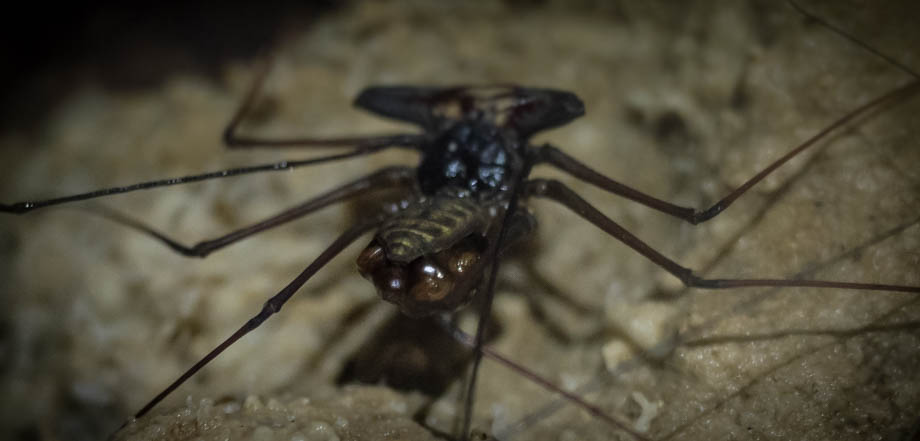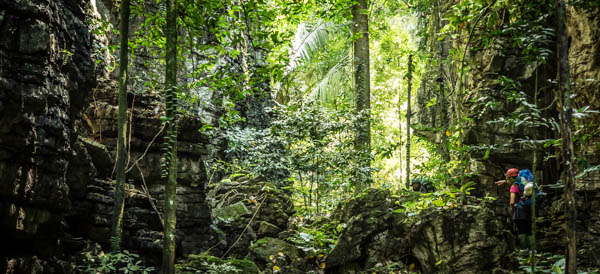Cave Fauna
Cave Fauna
One notable characteristic of cave ecosystems is the distinct lack of light (with the exception of partially-open caves like Taman cave). Since sunlight, via plant photosynthesis, makes up the base of the ecological pyramid, caves require a constant link to external ecosystems in order to transport energy and nutrients into them. There are many natural 'links', such as streams of rainwater or leaves that are blown in by the wind, but the most regular and efficient of them all, helping to deliver energy into the deepest, darkest recesses, are bats. Bats disperse this energy through their excrement, known as 'guano', which is full of organic matter and is the basis of an entire food chain. Layers of guano can accumulate over time and can create mounds that are several metres thick. In the Great Cave in Niah, Sarawak, for instance, there was at least 29 million kilograms, or 29000 tonnes, of guano. Wilford (1951) documented the presence of a layer of fresh guano that was 0.7 metres thick, that then merged with a layer of 'fossil guano' that was a staggering three metres thick. Underneath these layers lay almost a metre of 'rock phosphate', which consisted of insoluble phosphatic residue that had lost most of its organic content.

Unlike the other detrivores that we covered in the previous page, cave detrivores such as cave cockroaches and cave crickets can sometimes be found in enormous numbers within the layers of guano. In fact, the earliest known cave animals were detrivores. Two distant ancestors of modern cave cockroaches were found preserved in amber in a cave in Hukawng Valley in Myanmar, very close to the borders of China and India. They were named Mulleriblattina bowangi and Crenocticola svadba , and were found to be 99 million-years-old. This means that they were scuttling around with dinosaurs from the Cretaceous Period (65.5 to 145.5 million years ago). Cave crickets (Family : Rhaphidophoridae), also known as spider crickets, are not true spiders, nor are they true crickets (which instead belong to the family Gryllidae). Unlike true crickets, spider crickets do not attract mates with their melodic chirps (by the process known a 'stridulation'), but by emitting a scent instead.
Arachnids occupy the next tier above in the food pyramid as they prey upon many other arthropods. The strangest ones that you may come across are the whip spiders (Order : Amblypygi). These peculiar-looking arachnids are also not true spiders (which instead belong to the order Araneae), as they lack both venom glands as well as spinnerets, which are the silk-spinning organs of spiders. They instead have very long, spiked pedipalps (somewhat similar to those of a praying mantis) that are used to impale and grab their prey.


There are numerous true spiders that can be found within the caves, that range from large huntsman spiders (Family : Sparassidae), to the much smaller and much more ubiquitous orchard spiders (Leucauge spp.). The burrows of trapdoor spiders (Family : Ctenizidae) can also be seen within the caves, with their characteristic trip-lines that radiate out from the entrance giving them away.

Cave centipedes (Scutigera spp.) are also aggressive predators that happen to occupy the same tier as the arachnids. They are exceptionally fast for their size, and even have a unique tracheal system that ensures that oxygen is pumped into their body quickly in order to power their muscles. This speed and their strange appearance may be a little unnerving at first, but the fact that their venom is relatively harmless to humans should help ease any anxieties.
Although both large centipedes and spiders have been observed preying on bats, the cave-dwelling rat snake (Orthriophis taeniurus ridleyi) occupies the top spot on the food pyramid. This snake is a fantastic climber that is able to spend its entire life inside a cave and prey exclusively on cave swiftlets and bats. It does not have any venom-injecting fangs, and instead kills by constriction, after hanging down from the rooves of caves and snatching prey from the air as they fly past.







